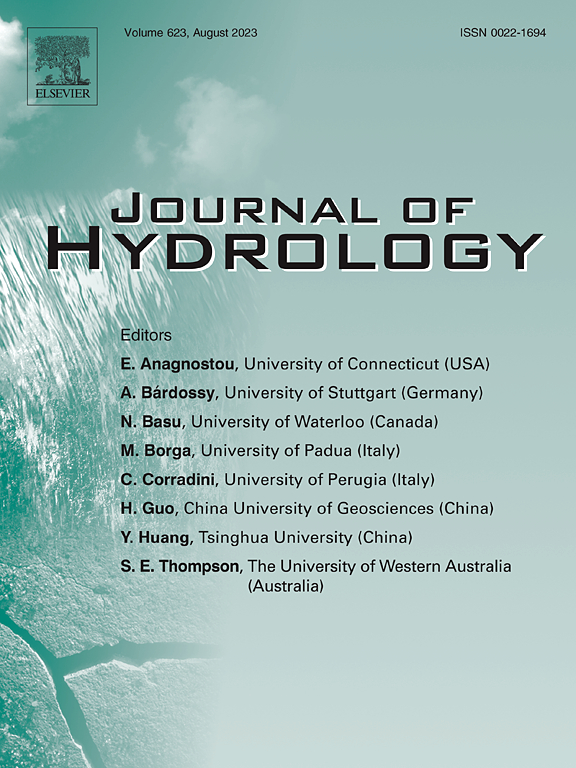黄河流域干旱-植被损失耦合对生态水文稳定性的影响评价
IF 5.9
1区 地球科学
Q1 ENGINEERING, CIVIL
引用次数: 0
摘要
在极端气候事件不断增加和环境脆弱性不断加剧的双重压力下,水文系统退化和植被损失可能在生态水文系统(EHS)内形成正反馈回路,生态水文稳定性评估成为当务之急。然而,以往的研究大多侧重于仅从干旱的角度评估风险,在将干旱与植被损失联系起来时往往忽略了植被对干旱响应的时间效应。通过生态水文稳定性评估风险的潜力在很大程度上仍然未知。基于此,本研究基于植被对干旱的响应模式,采用Copula模型构建了标准化干旱-植被复合损失指数(SCDVI),并基于稳定性(即抗旱性和恢复力)对黄河流域EHS风险进行了量化。结果表明,长江三角洲湿地的响应模式具有明显的空间异质性和季节差异,夏季对生产力的影响更为显著和敏感,以短期响应模式为主(64.1%的面积响应时间小于3个月)。陇西地区东南部主要处于暖温带落叶阔叶林区,生态水文稳定性最低。研究还发现,植被生产力高的地区更容易出现高抗性-低恢复力的权衡,而植被生产力低的地区则表现出相反的权衡。这些发现为实施有针对性的生态水文恢复策略以促进水资源可持续性和植被稳定性之间的平衡提供了科学见解。本文章由计算机程序翻译,如有差异,请以英文原文为准。
Evaluating the impact of drought-vegetation loss coupling on eco-hydrological stability in the Yellow River Basin, China
Under the dual pressures of increasing extreme climate events and escalating environmental vulnerability, the degradation of hydrological systems and vegetation loss may create a positive feedback loop within the eco-hydrological system (EHS), assessing the eco-hydrological stability has become an urgent priority. However, most previous studies have focused on assessing risks from the perspective of drought alone, often overlooking the temporal effects of vegetation responses to drought when linking drought with vegetation loss. The potential of evaluating risks through eco-hydrological stability remains largely unknown. Therefore, this study constructed the Standardized Compound Drought-Vegetation Loss Index (SCDVI) using a Copula model based on vegetation response patterns to drought, and quantified EHS risk based on stability (i.e., resistance and resilience) in the Yellow River Basin (YRB), China. Results indicated that the response pattern in the YRB exhibited substantial spatial heterogeneity and seasonal variations, with productivity being more significantly and sensitively affected during the summer when short-term response patterns dominated (64.1 % of the area had a response time of less than three months). The southeastern YRB, primarily located in the warm temperate deciduous broadleaf forest region, exhibited the lowest eco-hydrological stability. The study also found that regions with high vegetation productivity were more prone to a high resistance–low resilience trade-off, while areas with low vegetation productivity exhibited the opposite trade-off. These findings provide scientific insights for implementing targeted eco-hydrological restoration strategies to facilitate a balance between water resource sustainability and vegetation stability.
求助全文
通过发布文献求助,成功后即可免费获取论文全文。
去求助
来源期刊

Journal of Hydrology
地学-地球科学综合
CiteScore
11.00
自引率
12.50%
发文量
1309
审稿时长
7.5 months
期刊介绍:
The Journal of Hydrology publishes original research papers and comprehensive reviews in all the subfields of the hydrological sciences including water based management and policy issues that impact on economics and society. These comprise, but are not limited to the physical, chemical, biogeochemical, stochastic and systems aspects of surface and groundwater hydrology, hydrometeorology and hydrogeology. Relevant topics incorporating the insights and methodologies of disciplines such as climatology, water resource systems, hydraulics, agrohydrology, geomorphology, soil science, instrumentation and remote sensing, civil and environmental engineering are included. Social science perspectives on hydrological problems such as resource and ecological economics, environmental sociology, psychology and behavioural science, management and policy analysis are also invited. Multi-and interdisciplinary analyses of hydrological problems are within scope. The science published in the Journal of Hydrology is relevant to catchment scales rather than exclusively to a local scale or site.
 求助内容:
求助内容: 应助结果提醒方式:
应助结果提醒方式:


